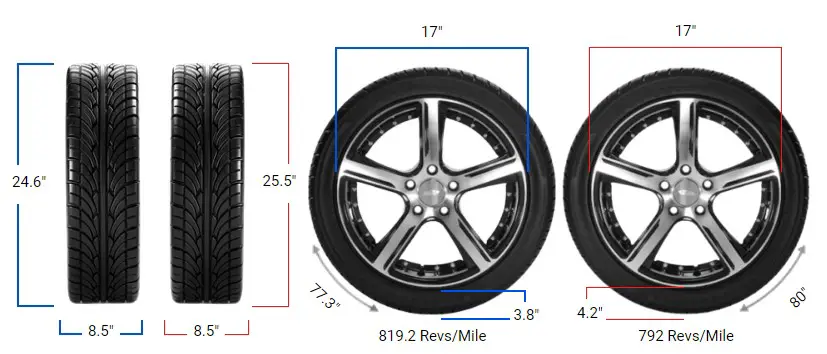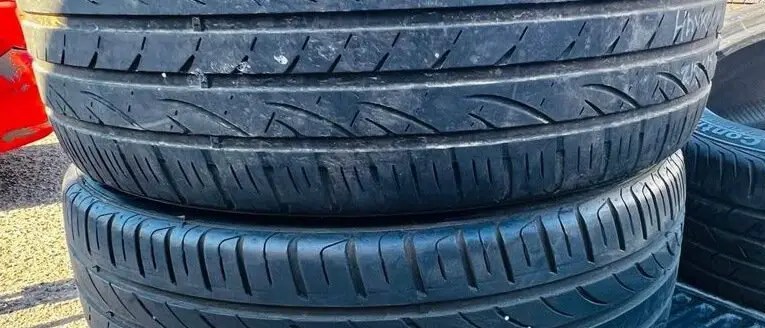Tire Size 215/45r17 vs 215/50r17

When replacing tires, it’s crucial to understand how different sizes affect your vehicle’s performance, handling, and appearance. Switching from 215/45r17 to 215/50r17 tires may seem like a minor change, but it can have notable effects on your driving experience.
- The overall diameter increases by 3.4%, which is just outside the recommended range
- The sidewall height increases by 11.1%, affecting aesthetics and handling
- Speedometer readings will be slightly off due to the change in tire size
- Ground clearance and ride comfort may improve with the taller sidewall
- Gas mileage and durability could be slightly affected by the switch
215/45r17 vs 215/50r17 Table
The main difference between 215/45r17 and 215/50r17 tires is the sidewall height, which increases by 11.1% when switching to the latter.

Fitment Guide
The diameter difference between tire sizes exceeds the acceptable 3% range, the interchange is not recommended without necessary adaptations. In this case, the 3.4% increase in diameter when switching from 215/45r17 to 215/50r17 tires slightly exceeds the recommended range.
On-Road Impact
Switching to tires with a taller sidewall can have various effects on your vehicle’s on-road performance. Here are some potential impacts:
- Speedometer Accuracy: Due to the increased overall diameter, your speedometer may read slightly slower than your actual speed. At 20 mph (32.19 km/h), your actual speed would be 20.69 mph (33.29 km/h).
- Ride Comfort: The taller sidewall of the 215/50r17 tires may provide a slightly more comfortable ride, as the increased air volume helps absorb road imperfections and vibrations.
- Handling: The taller sidewall may result in a slight reduction in responsiveness during cornering and quick maneuvers, as the tire’s sidewall flexes more than the shorter 215/45r17 sidewall.
- Gas Mileage: The increased overall diameter may slightly impact your vehicle’s gas mileage, as the engine needs to work slightly harder to maintain the same speed.

Off-Road Impact
If you take your vehicle off-road, switching to 215/50r17 tires can offer some advantages:
- Ground Clearance: The taller sidewall of the 215/50r17 tires can provide a slight increase in ground clearance, which may be beneficial when navigating rough terrain or obstacles.
- Traction: The increased tire volume may offer improved traction in loose surfaces like sand, gravel, or mud, as the tire can conform to the terrain more easily.
Can I Use 215/50r17 Instead Of 215/45r17?
Using 215/50r17 instead of 215/45r17 increases the tire diameter by 3.4%, exceeding the recommended 3% limit. It’s generally not advised due to potential speedometer inaccuracies and handling issues.
Additionally, ensure the load capacity of 215/50R17 meets or exceeds that of the original tire for safety and performance.

What Does 215/45r17 Mean?
The dimensions of the 215/45r17 tire are equal to those of the 24.6×8.5R17 size in inches. The tire size “215/45R17” denotes a tire that is 215 millimeters wide with a sidewall height of 45% of the width.
The “R” signifies radial construction, the most common type, and the “17” indicates it fits a 17-inch wheel.
What Does 215/50r17 Mean?
The 215/50R17 tire size is equivalent to the 25.5×8.5R17 size when converted to inches. The 215/50R17 tire size refers to a tire that is 215 millimeters wide with a sidewall height that is 50% of that width.
The “R” indicates radial construction and the 17 designates that this tire fits on a 17-inch diameter wheel.
How Much Taller Is A 215/45r17 Tire Than A 215/50r17?
To put it simply, the 215/50R17 tire is 0.85 inches or 21.5 mm taller than the 215/45R17 tire. The 215/50R17 tire has a height of 25.46 inches, while the 215/45R17 tire has a height of 24.62 inches.
This means that the 215/50R17 tire is approximately 3.4% taller than the 215/45R17 tire.
Our Observation
While switching from 215/45R17 to 215/50R17 tires offers some benefits, such as improved ride comfort and slightly increased ground clearance, it’s essential to consider the potential drawbacks.
The 3.4% difference in overall diameter exceeds the recommended 3% range, which may lead to rubbing or clearance issues if not properly addressed. Additionally, the speedometer accuracy will be slightly affected, and there may be a minor impact on fuel efficiency.
However, for most daily driving scenarios, the differences between these tire sizes are likely to be negligible. The impact on on-road performance, such as handling and braking, should be minimal.
If you frequently drive off-road, the taller sidewall of 215/50R17 tires can provide some advantages in terms of traction and durability.

Meet Caitlin McCormack, a Tire Size Expert and Blogger Passionate About Everything Related to Tires. With Years of Experience in the Tire Industry, Caitlin Has Become an Expert in Tire Sizes and Their Impact on Vehicle Performance.
